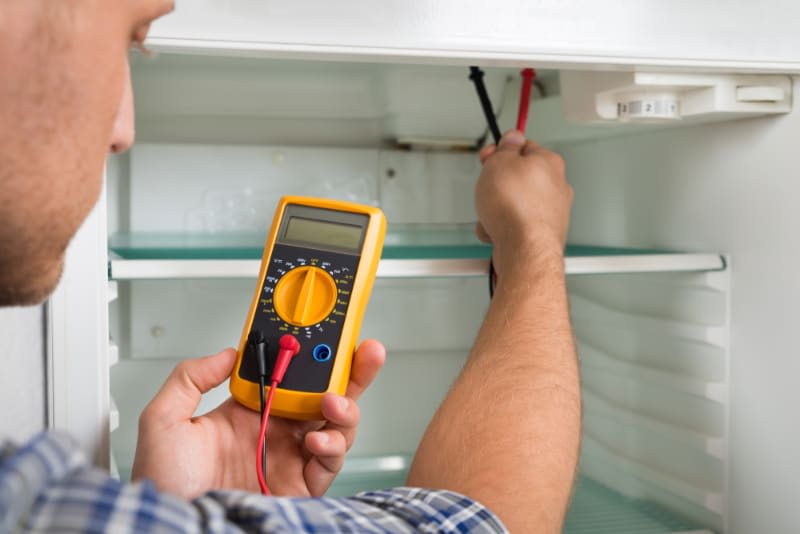These days we are more conscious about trying to save energy and money. To save the most per year, we have a way to find out how many amps a refrigerator uses.
Of all the electronic appliances in the home, the fridge uses the second-highest amount of electricity – right after your AC. The U.S. Department of Energy says that a refrigerator, on an average, uses around 15 – 20 amps and 725 watts of energy.
If you’re looking for exact wattage and energy use, head over to the energy.gov website. Sometimes this can be equal to 10% of the total energy consumption in your home, or more.
It can be tricky to calculate the power consumption of refrigerators, given that refrigerators do not continuously use 100% of the drawn power. The homes power source also determines how to calculate the amperage.
You should basically check the compressor’s consumption and the general specifications that your manufacturer gives. Generally, it has the highest specs.
As an example, if at 12V your refrigerator compressor uses 4 Amp power, you have to multiply 4 Amp with 12V. This will give you 48 watts. If you live in a warm-weather country, you can be assured that the fridge will work effectively for about 8 hours.
Multiply 8 hours with 48 watts and you can get around 384 watt-hours every day.
Do I need a dedicated circuit for a refrigerator?
Yes, according to the experts at Tru-Line electric, having a refrigerator on its own dedicated circuit is best practice for any homeowner. Planning for an amperage draw of 15 amps preps the electrical outlet to handle an unforeseen spike.
Mr. Electric also says that the National Electric Code (NEC) requires dedicated circuits for major appliances. A refrigerator power outlet can come from a branch circuit that leads back to the circuit breaker.
Can I run a refrigerator on a 15 amp circuit?
If your refrigerator does not surge about 15 amps, you can use a dedicated 15 amp circuit. The surge calculation needs to include what the compressor draws at start-up.
An example of a refrigerator appliance that meets the 15 amp conditions would be one that is energy star qualified and designed for the kitchen.
Does a fridge need a 20 amp circuit?
Household refrigerators use 15 to 20 amps through their power supply when plugged into a wall outlet. If you are in question about moving from a 15 to 20 amp circuit, consider the max electrical current that will be running through the refrigerator cord.
a 20 amp circuit can help if a refrigerator on start-up goes over even 10 percent of the refrigerator amps calculated
What Are The Amps Actually?
An amp measures the electricity flow rate. The sizes of wire and circuit breakers are determined by electrical codes on the basis of amps. A circuit overload gets the wires overheated and results in a fire hazard.
When more than one appliance tends to work on the same circuit, the total amps for every appliance have to add up to less than the wire and circuit breaker rating.

How Many Amps Does a Refrigerator Use (Calculation)
The answer isn’t quite simple. A standard frost-free, 16-cubic-foot fridge uses 750 watts and consumes 6 amps electricity.
In the U.S, the amps are decided by dividing the total number of watts by 120 V. The amps of a particular refrigerator are calculated easily on the basis of the watts that the manufacturer’s label lists.
Refrigerator amps mean the amount of electrical energy used by a refrigerator compressor to cool down the compartment. For most domestic fridges, the amperage ranges between 3 and 5 in the case of 120 V.
How many amps or watts does a refrigerator use on startup?
On startup, you can calculate the refrigerator compressor draw to understand amps and wattage.
Best tools for this is a clamp meter or multimeter. A clamp meter is typically used for amperage, and a multimeter is more for voltage or resistance
Amperage equals the unit’s wattage divided by voltage.
To put simply, Amperage = Watts/Voltage.
In the United States, voltage is standardized as 120 volts.
When you consider this fact, any refrigerator of small size having up to 240wattage would fall under the restriction of 2amps that is prevalent in most colleges.
Most small fridges are powered by the Energy Star technology, which can reduce the power consumption of a fridge per year.
How many amps does a refrigerator use, when it comes to domestic refrigerators, the consumption of power is generally in the range of 100 – 200 watts.
Through a whole day, these are likely to consume about 1 – 2 kWh or kilowatt-hours. Old commercial and domestic refrigerators draw more energy.
Refrigerator Appliance Amperage Factors
Other appliances like a microwave can affect the current that a refrigerator uses in the kitchen if it’s on the same circuit. But there are also a number of other factors that change what a refrigerator uses.
Location of your home’s fridge
In case you place the refrigerator in a warm area, such as adjacent to the oven or in an area with poor ventilation, the compressor will have to work much harder.

Number of cubic feet the fridge uses
Generally, bigger sized fridges tend to hog more energy.
Usage
In case the door of the refrigerator is held open for long or opened often, the compressor will have to operate harder in order to cool the area.
An empty refrigerator will have to work more as compared to one that is well-stocked, given that ‘warm air’ will replace more ‘cool air’ every time you open its door.
Temperature setpoint
A factory setting might keep your refrigerator cooler in your house than it is necessary. For safe storage of foods, keep the temperature in the range of 3 – 5 degrees Celsius.
Make sure that your freezer and fridge temperatures are no needlessly cold with such a thermometer.
Age
Generally, older refrigerators have lower efficiency as compared to newer refrigerator models.
Condition
Look at the seals surrounding the door. In case the seals are worn out, the efficiency will be less. It is important to get home an Energy Star-rated fridge to reduce the consumption of power by the compressor.
You can also control the usage of power in many other ways, such as by being watchful and knowing how to properly use your refrigerator.
Do not leave an empty refrigerator running. The fuller your fridge is, the less the amount of power it consumes.
This happens because the things that you keep inside will prevent the escape of cold air when the fridge is opened. Thus, it does not have to operate harder to freeze again.
Older refrigerators also have to be avoided, as these use more amount of power. These do not have the Energy Star technology that saves power. The smaller the size of the fridge, the less the consumption of power would be.
Regularly defrosting your refrigerator can keep it proper, operational state and also restrict the usage of power. You can also reduce power consumption by not letting your fridge stand in direct sunlight.
Reducing how many times the refrigerator is opened and closed and ensuring that it is over a level surface. Typically, although a refrigerator consumes a lot of power you are unlikely to spot any difference in your electric bills when you use mini-fridges.
The operational costs of the average refrigerators are around 10 USD per month. That might not be a big deal for a single home, and family members are unlikely to give much thought to it.
But, 5 dollars per room can begin to add up for college dorms with 100 rooms or more. Due to these reasons, colleges have restrictions about the amps that can be used by fridges.
Conclusion
Once you have calculated the energy use of your fridge in amperage, try to reduce the consumption to lower bills as much as possible.

